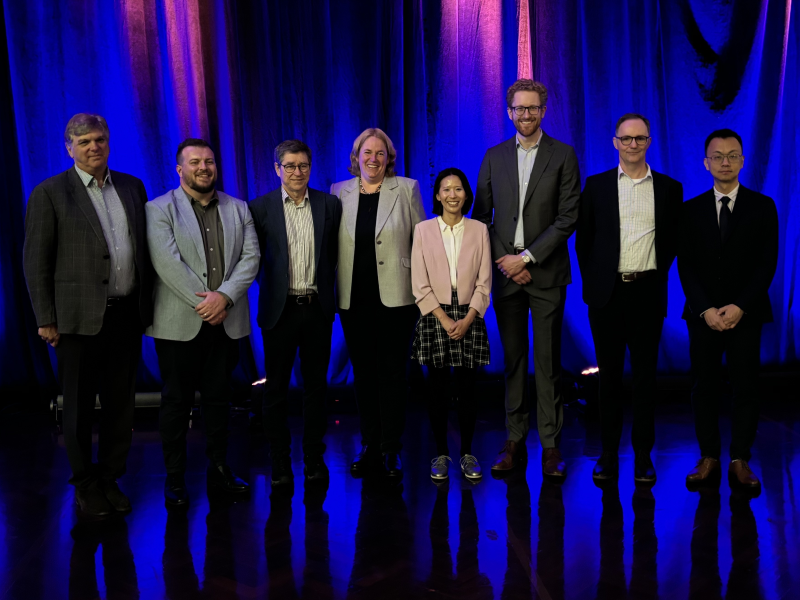Astrophysicist Matthew Bailes has taken out Australia’s top science prize for his part in the discovery of fast radio bursts – millisecond-duration radio flashes that can be used to calculate the mass of the universe.
Professor Bailes was awarded the 2024 Prime Minister’s Prize for Science on Tuesday evening, joining some of the country’s most decorated scientists such as 2023 winner, quantum physicist Michelle Simmons. It has been an incredible 12 months for Professor Bailes, who last year was awarded the prestigious Shaw Prize.
There were seven prizes on offer at the 25th annual Prime Minister’s Prizes for Science, with Quantum Brilliance co-founder Dr Andrew Horsley awarded the Prize for New Innovators for his quantum computing breakthroughs.

Next year will include a new category to recognise the contributions of Aboriginal and Torres Strait Islander knowledge systems. It comes after indigenous knowledge systems were recognised in the national science and research priorities earlier this year.
The incoming category will include a prize of $250,000, Industry and Science minister Ed Husic announced on Tuesday, the same amount on offer to the winners of the Prime Minister’s Prize for Science and for Innovation. The other prizes award $50,000 to the recipients.
However, at the ceremony Prime Minister Anthony Albanese announced that “from tonight” the awards for excellence in primary school teaching and for secondary school teaching would be raised to $250,000 each.
The full list of winners are:
- Prime Minister’s Prize for Science: Swinburne University Professor Matthew Bailes for the co-discovery of FRBs and leadership of Australian astronomy research centres
- Prime Minister’s Prize for Innovation: BioTech Cytopia founders Dr Chris Burns and Professor Andrew Wilks. Dr Wilks’ discovered the JAK enzyme and the pair developed JAK-inhibitor Momelotinib, a drug for treating a type of blood cancer that has since been acquired by pharmaceutical giant GSK for nearly $3 billion
- Prize for New Innovators: Quantum Brilliance co-founder Dr Andrew Horsley in recognition of his quantum computing breakthroughs including the use of synthetic diamonds to build room temperature devices
- Malcolm McIntosh Prize for Physical Scientist of the Year: RMIT University Distinguished Professor Tianyi Ma for the development of novel low-cost green hydrogen production technology and carbon capture, storage, and utilisation technology
- Frank Fenner Prize for Life Scientist of the Year: University of Western Australia Professor Britta Regli-von Ungern-Sternberg for research into reducing the risks associated with anaesthesia for children to make surgery and recovery safer
- Prime Minister’s Prize for Excellence in Science Teaching in Primary Schools: Daniel Edwards from Montello Primary School in Tasmania for developing a STEM and digital technologies program. He also founded the charity Green STEM Education.
- Prime Minister’s Prize for Excellence in Science Teaching in Secondary Schools: Alice Leung from Concord High School in New South Wales for creating programs that improve access to technical scientific vocabulary for students from culturally and linguistically diverse backgrounds
Using the CSIRO’s Parkes radio telescope Murriyang, Professor Bailes and two other scientists detected the first fast radio bursts (FRBs) ever discovered in 2007. FRBs are intense radio wave signal emitted from billions of light years away over very short time periods of around a few milliseconds.
The radio signals embed information about the number of electrons between their point of origin and Earth, which can be used to calculate the mass of normal matter along those lines and sheds light on areas between galaxies that were previously difficult to investigate.
But he said that it probably took another six years before the science community came to accept that FRB were “probably real” and a further couple of years before “there was incontrovertible proof”.
This is partly because radio telescope readings are affected by human interference. For example, the Parkes radio telescope has previously been affected by interference microwave ovens used by on-site staff.
“It was a bit of a slow burn first, and FRBs actually turned out to be very difficult to discover with existing telescopes. So people were finding, sort of three to five a year,” Professor Bailes said.
“And then probably around 2019, telescopes were built that were designed to discover them, and we now have thousands of them”.
Professor Bailes’ receipt of the Prime Minister’s prize for science comes a year after he became the second Australian to receive the internationally prestigious Shaw Prize for Astronomy for the co-discovery of FRBs, alongside Western Virginia University Professors Duncan Lorimer and Maura McLaughlin.
He has led the internationally regarded Australian Research Council Centre for Excellence for Gravitational Wave Discovery (OzGrav) since 2016.
Australia’s outgoing chief scientist Cathy Foley, who led the judging panel for her fourth and final time, on Monday said the 2024 Prime Minister’s Prizes for Science recipients are all “truly top class and world leading”.
Professor Foley also said the volume of nominations having grown year on year and that the prizes are a reminder of “just how much incredible science” is done in Australia.
Industry and Science minister Ed Husic also congratulated the recipients on their “remarkable achievements, in particular, your perseverance, your passion and your dedication that cannot be underestimated”.
Do you know more? Contact James Riley via Email.

